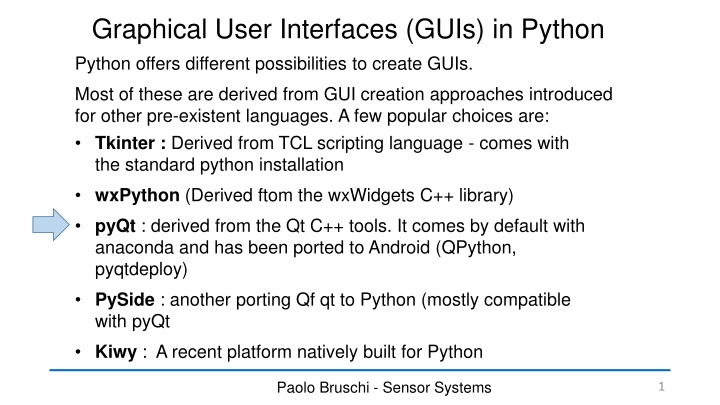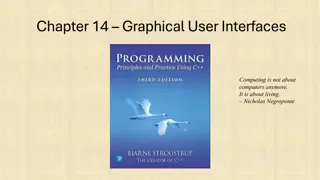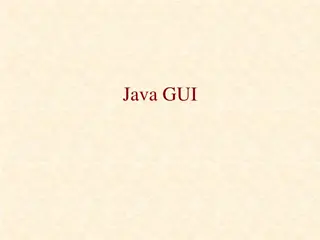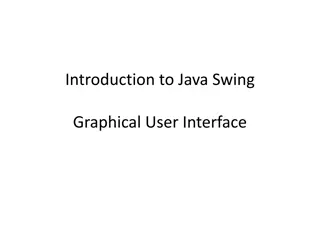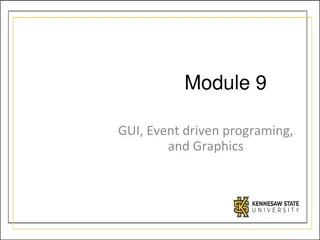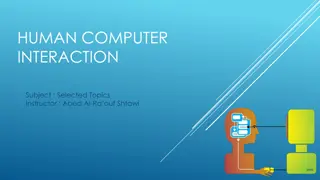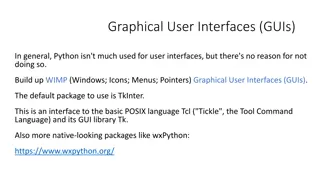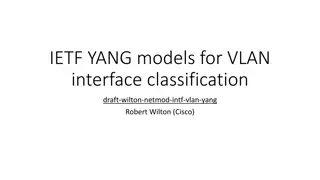Graphical User Interfaces in Python: GUI Creation Possibilities
Python offers various options for creating graphical user interfaces (GUIs), derived from existing approaches in other languages. Popular choices include Tkinter, wxPython, PyQt, PySide, and Kiwy. PyQt, based on Qt, is a powerful tool for GUI development. The structure of a GUI involves widgets and windows. PyQt's principle of operation centers around loading the QApplication program and executing the GUI's loop. PyQt modules like QtWidgets, QtGui, and QtCore offer classes for building simple GUIs, painting, non-graphical operations, and more.
Download Presentation

Please find below an Image/Link to download the presentation.
The content on the website is provided AS IS for your information and personal use only. It may not be sold, licensed, or shared on other websites without obtaining consent from the author.If you encounter any issues during the download, it is possible that the publisher has removed the file from their server.
You are allowed to download the files provided on this website for personal or commercial use, subject to the condition that they are used lawfully. All files are the property of their respective owners.
The content on the website is provided AS IS for your information and personal use only. It may not be sold, licensed, or shared on other websites without obtaining consent from the author.
E N D
Presentation Transcript
Graphical User Interfaces (GUIs) in Python Python offers different possibilities to create GUIs. Most of these are derived from GUI creation approaches introduced for other pre-existent languages. A few popular choices are: Tkinter : Derived from TCL scripting language - comes with the standard python installation wxPython (Derived ftom the wxWidgets C++ library) pyQt : derived from the Qt C++ tools. It comes by default with anaconda and has been ported to Android (QPython, pyqtdeploy) PySide : another porting Qf qt to Python (mostly compatible with pyQt Kiwy : A recent platform natively built for Python Paolo Bruschi - Sensor Systems 1
Qt and pyQt Qt (https://www.qt.io/) is a series of multi-platform tools, basically aimed at the creation of GUIs with C++. It is free and consists of a series of libraries and a preprocessor (the code is an extension of C++). First version by TrollTech (Oslo) in 1995. At present, Qt is being developed by the Qt group (Helsinki) PyQt maintains the same classes of Qt and the way they are organized in modules. Differently from the original C++ version, the Python syntax is completely respected, and no preprocessing is required PyQt latest version, pyQt6, but latest version in Anaconda is still pyQt5 (April 2023) The complete documentation refer to the original Qt (C++): https://doc.qt.io/qt.html (Focused on Qt6, mostly compatible with Qt5) Paolo Bruschi - Sensor Systems 2
Structure of a GUI: widgets The GUI is a "widget" Widget is an English word that indicates a small mechanical device. Any smaller object that forms the GUI is a widget The widget that is not included into other widgets is called "window" (it is the top widget (or "parent widget") x y window window coordinate system (units: screen pixels) Paolo Bruschi - Sensor Systems 3
pyQt principle of operation In order to allow access to the graphical APIs of the operating system, it is necessary to load a resident program ("QApplication") at any execution of the Python code. from PyQt5 import QtWidgets import sys app = QtWidgets.QApplication(sys.argv) In order to allow the GUI to intercept actions from the user (e.g. mouse clicks), it is necessary to execute the loaded program (the GUIs "loop"). sys.exit(app.exec_()) This program will be terminated when all the GUI's windows are closed Paolo Bruschi - Sensor Systems 4
PyQt (Qt) modules for GUIs QtWidgets: includes most high level built-in widgets and prototype classes for creation of simple GUIs low level painting (e.g. QPainter and its primitives) and classes for bitmap import. QtGui: Includes non-graphical classes (e.g. QTimer) Includes also support for mutli-threading, constant values definitions, support for animation and more. QtCore: Paolo Bruschi - Sensor Systems 5
PyQt principle of operation: signals and slots Events are detected by the loop and proper signals are emitted Signals may be connected to slots Events signal slot 1 Mouse clicks signal slot 2 Keyboard hits signal Touch operations signal Timer overflow slot 3 signal slot 4 other events Paolo Bruschi - Sensor Systems 6
Events, signals and slots in a GUI A simple GUI consists in a custom class that inherits from a proper PyQt class The GUI may include objects (instances of classes) that are capable of detecting an event and generating a signal Built-in pyQt objects are capable of generating different signals. For example, a push button can generate different signals when it is clicked or simply pressed or released. Using a proper and simple construct, the user can connect these signals to slots. A slot can be any member function of the GUI class Paolo Bruschi - Sensor Systems 7
Syntax Inherits from QWidget (prototype for simple guis.) class my_gui(QtWidgets.QWidget): def __init__(self) super().__init__() Inizitializes the parent class bt1=QtWidgets.QPushButton("Exit") Create an instance of a button with label "Exit" bt1.clicked.connect(self.fine) Connects the signal emitted when the button is clicked to a member function def fine(self): ... ... Paolo Bruschi - Sensor Systems 8
A few useful built-in widgets Buttons: QPushButton() Up-down numerical fields: QDoubleSpinBox() Multiple choice selector: QComboBox() Label used as a display: QPushButton() Text Input: QLineEdit() Paolo Bruschi - Sensor Systems 9
Layouts Layouts help placing objects (widgets) into the main widget space. The layout create the space required by each widget and align them automatically. widget widget widget widget widget Horizontal layout: QVBoxLayout() widget widget widget widget widget Two horizontal layout arranged into a vertical layout widget Vertical layout: widget widget QVBoxLayout() Paolo Bruschi - Sensor Systems 10
Layouts: including elements into a layout A Layout starts as an empty container Widgets are added at the bottom of the layout vlay=QtWidgets.QVBoxLayout() vlay.addWidget(wid1) vlay.addWidget(wid2) wid1 wid2 Creating a horizontal layout and populating it with two widgets hlay=QtWidgets.QHBoxLayout() hlay.addWidget(wid3) hlay.addWidget(wid4) wid1 Inserting the h-layout at the bottom of the v-layout Add a stretchable space Apply Vlay to the main widget wid2 vlay.addLayout(hlay) vlay.addStretch(hlay) wid3 wid4 self.setLayout(vlay) Paolo Bruschi - Sensor Systems 11
Changing the apparence of the widgets: StyleSheets wid.setStyleSheet("color : red; font-size : 12pt") Most frequently used properties: properties values background-color color colors, values: font-size ( pt or px) rgb(r,g,b) font-style (normal, italic) or a color name: font-weight (normal bold) red, black, white, blue, yellow, green ... font-family (es. Times New Roman text-align (left,right,center, ...) Paolo Bruschi - Sensor Systems 12
Timing events: QTimer Creates the timer from PyQt5 import QtCore Connects timer overflows to a slot self.tm=QtCore.QTimer() self.tm.timeout.connect(self.acquire) Sets the time interval between overflows self.tm.setInterval(500) self.tm.start() Starts the timer self.tm.stop() Stops the timer Paolo Bruschi - Sensor Systems 13
